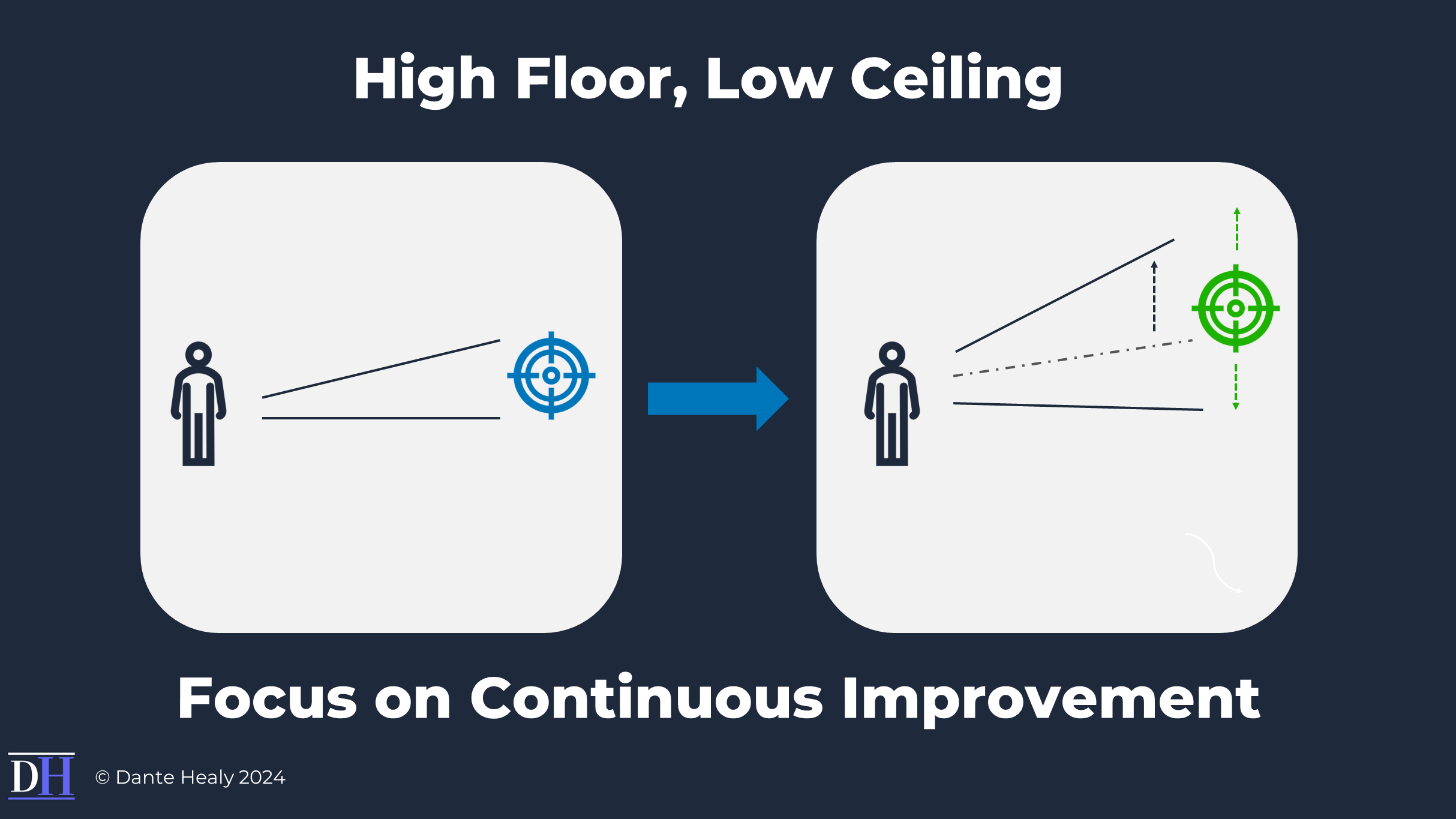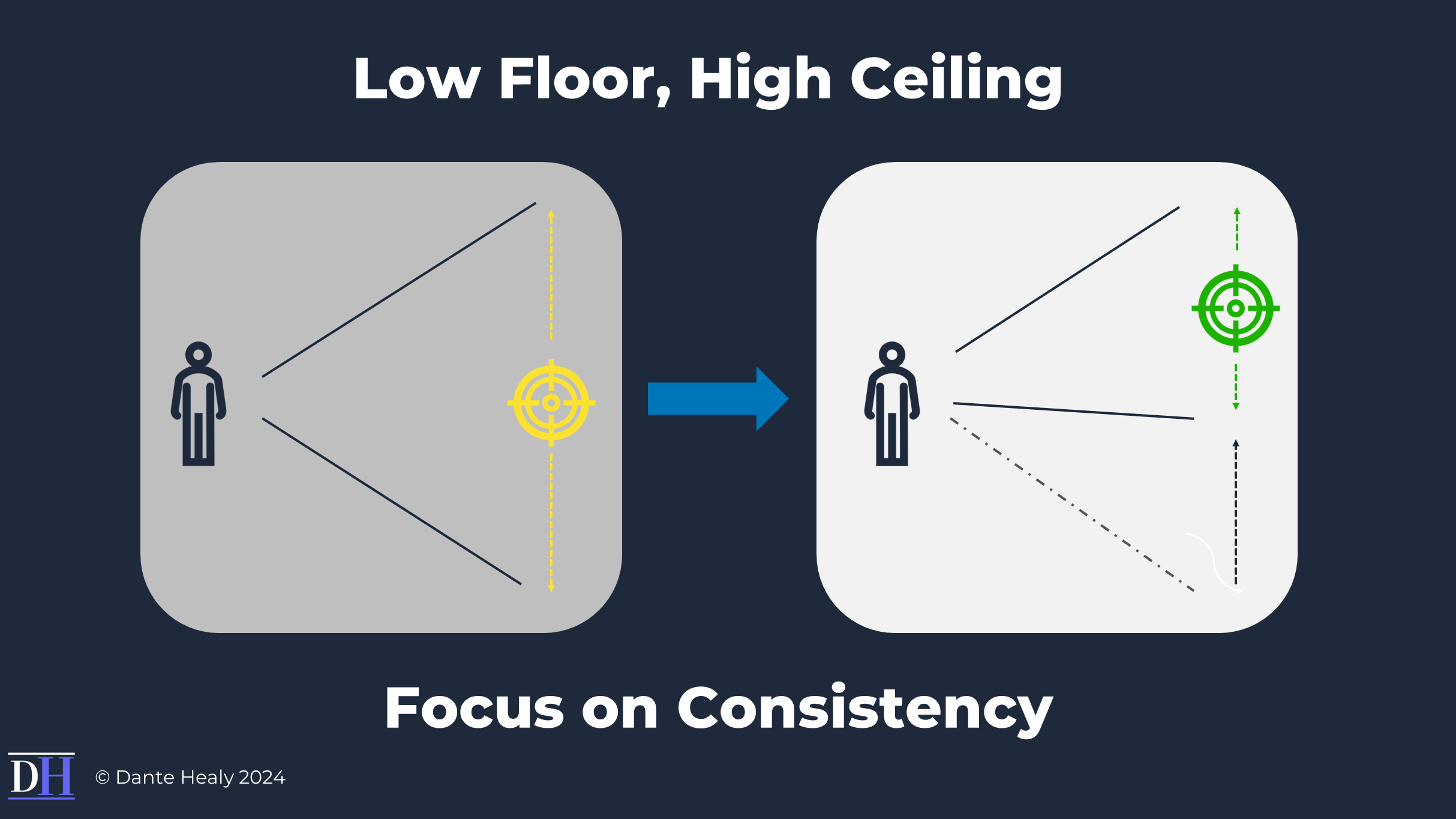Breaking the A-Player Paradigm: Why Raising the Floor Beats Raising the Ceiling!
Reframing Talent Strategy in Finance Transformation.
In the fast-evolving domain of finance transformation, the quest for 'A' players often mirrors the search for the Holy Grail: a fervent and elusive myth. This pursuit, while well-intentioned, overlooks a critical reality - the true 'A' player talents, those who consistently deliver exceptional transformative outcomes, are remarkably scarce treasures.
This scarcity poses a pivotal challenge, especially in niche areas like finance transformation where the blend of skills required is as unique as it is demanding. My experience has shown me that focusing on nurturing the collective capabilities of B and C players not only democratises talent development but also ensures our teams are resilient, adaptable and better prepared for the challenges of finance transformation.

Enhancing Team Performance: Beyond Individual Brilliance
Enhancing Team Performance: Beyond Individual Brilliance
The magic of a high-performing team lies not in individual stardom but in the synergy of its members. The Performance Quadrant, assessing team members by their reliability (the floor) and their potential for peak performance (the ceiling), encourages us to see beyond labels and recognise the unique value each person brings.
• High Floor, High Ceiling: Ideal but rare, these are the transformative stars.
• High Ceiling, Low Floor: Brilliant in moments but inconsistent, their unpredictability can challenge team stability.
• Low Ceiling, High Floor: The team's backbone, providing steady, reliable performance.
• Low Floor, Low Ceiling: Those struggling to contribute effectively, needing focused development or transitioning out.
This model underlines the importance of cultivating a team where diverse strengths are harmonised, ensuring the whole is indeed greater than the sum of its parts.
In his book ‘The end of average’, Todd Rose's critique of average-based measurements supports this argument, emphasising that the 'average' is a flawed metric that fails to capture the unique abilities and potential of individuals. Recognising each team member's unique value aligns with his advocacy for personalised pathways to success, challenging us to rethink how we evaluate and develop talent within our teams.

The Strategic Imperative of Developing B and C Players
The Strategic Imperative of Developing B and C Players
In the intricate dance of finance transformation, the spotlight often falls on the A players, the assumed linchpins of success. However, this focus obscures a profound truth: the bedrock of enduring team success often lies in the collective strengths of B and C players.
These team members, with their consistent performance and untapped potential, are the unsung heroes of transformation initiatives. Recognising and leveraging their strengths not only enriches the team's capabilities but also cultivates a culture of growth and resilience.
Echoing Todd Rose's emphasis on the significance of individual strengths, it becomes evident that traditional talent development models, which often chase an illusory standard of excellence, fail to harness the true potential of B and C players. By pivoting towards a model that values the distinctive capabilities of these individuals, we unlock a reservoir of untapped potential within our teams, underscoring the strategic imperative of this inclusive approach to talent development.
The reality in finance transformation is that 'A' players are not just hard to find; they're hard to keep. Enter 'MB' - a quintessential 'A' player whose eventual departure (after less than a year in position) underscored a vital lesson: Our success hinges not on the few but on the many.
In this case an internal development move was forced on me by the wider Finance talent committee which was to both MB’s as well as the organisation’s benefit, but for my Finance Transformation team and programme it set us back greatly.
Shifting our focus inward to identify alternative strategies, to the potential within our B and C players, offers a sustainable path forward. Here, the true potential for innovation and adaptability lies, not in the stars we wish upon but in the team foundations we build and nurture every day.
A study by the Corporate Executive Board (now Gartner) revealed that "B" players, who constitute about 60% of the workforce, offer the best long-term value to organisations, significantly contributing to overall performance and stability.

Why We Need to Shift Our Gaze
Why We Need to Shift Our Gaze
You see, true A players are like unicorns - rare, highly sought after and, let's be real, a bit of a fantasy for most Finance teams running tight ships on even tighter budgets. But in the trenches of finance transformation, it's often the B and C players who are pulling the load, making the plays to drive us forward.
The Strategic Value of B and C Players
The Strategic Value of B and C Players
In the world of finance transformation, we've often fallen into the trap of the A-player allure. You know the type - those shining stars that promise to illuminate our projects with their brilliance.
But here's a hot take: our real MVPs might just be hanging out in the more unassuming corners of our teams. Let's talk about the unsung heroes, our B and C players and why they might just be the secret sauce to sustained success.

Making It Work: Revealing Potential
Making It Work: Revealing Potential
So, how do we tap into this reservoir of potential? First off, it's about seeing the individual beyond a predefined label. Customised development plans are key. Imagine tailoring growth opportunities that align with each person's unique strengths and career aspirations.
It's about playing chess, not checkers - strategic moves that position each team member to play their best game.

Strategies for Recognising and Leveraging Strengths
Strategies for Recognising and Leveraging Strengths
Then there's the power of the right fit. Sometimes, it's not about changing the player but changing the game. Adjusting roles to better match an individual's talents can turn a perceived B player into an A player in the right context.
1. Individualised Development Plans: Tailor development opportunities to the specific strengths and aspirations of each B and C player. This personalised approach fosters engagement and accelerates growth.
2. Role Redefinition: Align roles with the innate strengths of team members, allowing them to thrive and contribute more meaningfully to team objectives.
3. Mentorship and Peer Learning: Pair B and C players with mentors who can guide their development and encourage peer learning sessions where team members can share knowledge and skills.
And let's not forget the magic of collaboration. Creating a culture where knowledge sharing is the norm, not the exception, fosters a team where everyone is leveling up together.
By shifting our focus from exclusively pursuing elusive A players to cultivating the abundant talent within B and C players, we not only build stronger, more resilient teams but also champion a more inclusive and sustainable approach to talent development in the ever-evolving landscape of finance transformation.

Real Stories from the Field
Real Stories from the Field
Let's ground this in reality with a few stories from my own playbook:
1. KF's Comeback: Returning from maternity leave to a team in disarray, KF didn't just catch up; she catapulted us forward. Her knack for anticipating issues and rallying her team transformed her from an under-the-radar B player to a linchpin in our operations.
With zero fuss, she not only cleared the backlog of project work left by her predecessors, but also anticipated future challenges, demonstrating a level of leadership and foresight that had previously gone unrecognised. KF's story exemplifies how B players, often seen as merely reliable, can display remarkable leadership qualities when given the opportunity.
2. OO the Steady Hand: Initially underestimated, OO's consistent delivery and quiet leadership became our rock. He proved that reliability and deep thoughtfulness in tackling tasks can outshine the occasional flashiness of more erratic performers.
His story is a testament to the fact that quiet diligence and reliability are invaluable traits that can stabilise and propel a team forward during transformative projects.
3. JM's Transformation: Once viewed as a C player, JM's analytical skills and hard work were underutilised. With a bit of coaching and the right opportunities, he became our go-to for navigating complex stakeholder waters, turning daunting challenges into wins for the team.
With support and coaching, he confidently navigated complex stakeholder interactions, defending his analyses and contributing significantly to the project's success. JM's journey highlights how proper support and trust in a C player's potential can lead to substantial personal growth and contributions to team success.
Reflecting on the "jaggedness principle" from Todd Rose, the unique journey of KF, OO and JM underscores the inadequacy of a one-size-fits-all approach to talent management. Their successes affirm the value of recognising and nurturing the distinct skills and traits each individual brings to the team, illustrating the profound impact of embracing individual differences on achieving superior outcomes.
These stories are not just feel-good moments; they're testaments to the transformative impact of recognising and investing in the depth of talent within our teams rather than simply skimming the surface.

The Bigger Picture
The Bigger Picture
Rethinking our approach to talent development isn't just a nice-to-have; it's a strategic imperative. By valuing and developing our B and C players, we're not settling - we're strategically bolstering the foundations of our team for long-term resilience and success.
So, let's start celebrating and leveraging the diverse strengths lying in wait within our ranks. After all, in the complex ballet of finance transformation, every player counts, and it's the harmony of the ensemble that creates the most compelling performances.
Cultivating a Culture of Trust, Diligence and Commitment
Cultivating a Culture of Trust, Diligence and Commitment
Now, if there's one thing I've learned, it's that the glue holding everything together is trust. It's not about one-time grand gestures; it's in the little, consistent things. Like being transparent about the challenges we're facing or taking the time to listen, "really listen", to what the team has to say. This builds the kind of trust that turns a group of individuals into a tight-knit team ready to conquer the world.
Drawing from Todd Rose's critique of average-based environments, it's clear that cultivating a culture that values the individuality and unique strengths of team members is foundational to fostering trust, diligence and a deep-seated commitment to success. This nuanced understanding of individuality forms the bedrock of a more engaged, motivated, and productive workforce, epitomising the shift from a generic to a personalised approach in talent development.
Then there's diligence. I'm talking about the grind, the consistent effort that turns 'good enough' into 'exceptional'. And here’s the kicker: when the team sees their leaders getting their hands dirty, diving into the trenches with them, it sets a fire under everyone to up their game.
But what really gets the engine roaring? A shared commitment to success. Aligning everyone's eyes on the prize, ensuring each person knows how vital their role is in the grand tapestry of our goals. That's when you see collective motivation skyrocket.

Empowering Leadership: Fostering Growth and Team Cohesion
Empowering Leadership: Fostering Growth and Team Cohesion
Leadership is an art and a science. But at its core, it's about empowering your team. It's about recognising the potential in each person and giving them the tools and opportunities to shine. Because here’s the truth: when people feel supported and valued, they do amazing things.
I’ve seen it firsthand. Like with KF, who jumped back in from maternity leave and took our backlog mess and turned it into a well-oiled machine. Or OO, whose quiet resilience and steady hand showed me that leadership isn't always loud. And let's not forget JM, whose journey from being underappreciated to becoming a project hero was nothing short of inspiring.
Recalling when this team faced that seemingly insurmountable project challenges? The stakes were high, and morale was low. Instead of doubling down on pressure, we paused. We talked, not about the project, but about what everyone was battling with, professionally and personally. It was empathy and strategic foresight that allowed us to realign, readjust, and tackle the project with renewed vigor and a sense of unity. That's the power of compassionate leadership.


When It’s Time to Say Goodbye with Dignity and Grace
When It’s Time to Say Goodbye with Dignity and Grace
While navigating the terrain of transformation and team leadership, an inevitable truth emerges - one that we, as leaders, must brace for. There will come moments when our people, despite our best efforts and their potential, may let us down. This realisation, though disheartening, is not a signal of defeat but a rite of passage in the journey of leadership. It's in these moments, fraught with disappointment and frustration, that our leadership is truly tested.
Not all stories have happy endings. Sometimes, we find ourselves with a team member who, despite our best efforts, just doesn't fit. It's tough, but part of our job as leaders is to manage these situations with as much grace and dignity as we can muster.
Take, for instance, AA. Her skills? Top-notch. Her approach to teamwork? Well, that needed some work. Her drive was commendable, but her approach caused friction with colleagues. When the time came, the conversation was straightforward, respectful, and focused on her strengths and future possibilities.
It wasn’t easy, but it was handled with the dignity she deserved, keeping the team's morale intact. When the time came for a heart-to-heart, it was about focusing on her strengths and framing her next steps in a way that opened doors rather than closed them.
Then there was SB, chasing dreams without laying the groundwork. Always chasing the spotlight without laying the groundwork. His departure, handled with a focus on what’s next for him, underscored the importance of fit - for both the team and the individual. Helping him find his path outside our team was a decision aimed at preserving the team's harmony and his own career growth.
And TM, a cautionary tale. Whose potential was clouded by her political machinations which undermined the collective team efforts. Facilitating her move to a role that better suited her aspirations and away from the team she disrupted was a strategic move that ultimately benefited all parties involved. Extracted from the team dynamics she had strained was a move for the greater good.
The key is not just in how we confront these challenges, but in how we rise above them. It's essential to remember the power of staying composed and maintaining our class, even when faced with setbacks. Responding with grace and poise doesn't just help in preserving relationships but also in setting a standard of behaviour for our team.
It underscores the importance of handling difficult situations with dignity, ensuring that even if bridges momentarily wobble under the weight of disappointment, they don't burn down completely.
In embracing this approach, we not only fortify our leadership but also lay the groundwork for a culture of resilience and mutual respect. This becomes our ethos, guiding us through the ebbs and flows of team dynamics and personal development.
It reminds us that the true essence of leadership lies not in the absence of challenges, but in the elegance of our response to them.

A Paradigm Shift in Talent Development
A Paradigm Shift in Talent Development
And so, we've navigated the twists and turns of talent management within the crucible of finance transformation. It's been a journey of discovery, challenging preconceived notions about who really drives success in our teams. As we stand on the precipice of this revelation, it's clear that a call to action is not just warranted - it's imperative.
We're tasked with reimagining the very fabric of how we assemble, nurture, and champion our teams. The spotlight, often solely fixated on the elusive A players, needs a wider beam - one that illuminates the untapped potential residing in our B and C players. It's about recognising the power of the collective, the strength in diversity and the value of each unique contribution.
Creating an environment where trust is the cornerstone and mutual growth is the goal isn't just beneficial; it's essential. This approach aligns seamlessly with the principles of inclusivity and development, forging a path that prepares our teams not just for the immediate challenges but for the evolving landscape of tomorrow.
Imagine a workplace where every team member, regardless of their label, feels valued, understood and empowered. This isn't a utopian dream; it's a strategic imperative for those of us steering the ship of finance transformation. In this new paradigm, we move away from chasing the brilliance of a select few to unlocking the collective potential of all our team members.
By doing so, we ensure that our teams are not merely bystanders in the future of finance transformation; they are the architects, the builders, and the visionaries shaping it. This shift doesn't diminish the value of high performers; instead, it broadens our perspective to appreciate and develop the wide array of talents within our teams.
As we close this chapter, the message is clear: the future of finance transformation lies in the hands of teams built on trust, diversity and a commitment to collective growth. By embracing this new paradigm, we don't just prepare for the unknowns of tomorrow; we create the future, today. Let's embark on this journey together, with open minds and a shared vision, ready to unlock the boundless potential within our teams.